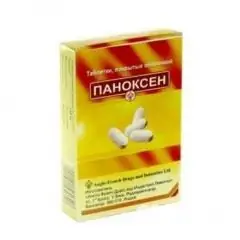- Author Rachel Wainwright [email protected].
- Public 2023-12-15 07:39.
- Last modified 2025-11-02 20:14.
Panoxen
Instructions for use:
- 1. Release form and composition
- 2. Indications for use
- 3. Contraindications
- 4. Method of application and dosage
- 5. Side effects
- 6. Special instructions
- 7. Drug interactions
- 8. Analogs
- 9. Terms and conditions of storage
- 10. Terms of dispensing from pharmacies
Prices in online pharmacies:
from 146 rubles.
Buy

Panoxen is a combined drug that has an analgesic effect.
Release form and composition
Dosage form of release of Panoxen - coated tablets: capsule-shaped, almost white or white, on one side - risk; the surface of the tablet may be slightly rough (10 pcs. in blisters, 2 or 10 blisters in a cardboard box).
Active ingredients in 1 tablet:
- Paracetamol - 500 mg;
- Diclofenac sodium - 50 mg.
Additional components: propyl parahydroxybenzoate (propylparaben) - 4 mg, methyl parahydroxybenzoate (methylparaben) - 17.5 mg, microcrystalline cellulose - 70 mg, talc - 10 mg, corn starch - 290 mg, acetylphthalyl cellulose (cellacefate) - 15 mg, diethyl 5 mg, magnesium stearate - 10 mg, titanium dioxide - 13 mg, povidone K-30 - 18 mg, white tablet coating TC 1005 (talc - 10.8 mg, hydroxypropyl methylcellulose (hypromellose) - 5.5 mg, propylene glycol - 4, 3 mg, titanium dioxide - 7.98 mg) - 28.5 mg.
Indications for use
- Neuralgia, sciatica, lumbago, myalgia;
- Inflammatory diseases of the musculoskeletal system: ankylosing spondylitis, rheumatoid arthritis, psoriatic, chronic and juvenile arthritis, acute gouty arthritis (to reduce pain and inflammation at the time of application);
- Diseases of the periarticular tissues: bursitis, tendovaginitis;
- Degenerative diseases of the musculoskeletal system: osteochondrosis, deforming osteoarthritis;
- Toothache;
- Post-traumatic pain syndromes with inflammation.
Contraindications
Absolute:
- Complete or incomplete combination of bronchial asthma with recurrent polyposis of the paranasal sinuses and nose and intolerance to acetylsalicylic acid or other nonsteroidal anti-inflammatory drugs (including indications in history);
- Erosive and ulcerative lesions of the gastrointestinal tract (including the duodenum);
- Inflammatory bowel disease;
- Active liver disease;
- Active gastrointestinal bleeding;
- Severe renal (with creatinine clearance <30 ml per minute), hepatic or heart failure;
- Progressive kidney disease;
- Hyperkalemia;
- The period after coronary artery bypass grafting;
- Childhood;
- Pregnancy and the period of breastfeeding (lactation);
- Hypersensitivity to the components of the drug, as well as to other derivatives of aniline or phenylacetic acid.
Relative (Panoxen is prescribed with caution in the presence of the following diseases / conditions):
- Hepatic porphyria, benign hyperbilirubinemia (including Gilbert's syndrome);
- Peptic ulcer of the stomach and duodenum (remission or the presence of indications in the anamnesis);
- Granulomatous enteritis;
- Ulcerative colitis;
- History of liver disease;
- A significant decrease in the volume of circulating blood (including after extensive surgical interventions);
- Arterial hypertension;
- Viral hepatitis;
- Alcoholism, alcoholic liver damage;
- Chronic heart failure of mild to moderate severity;
- Bronchial asthma;
- Peripheral artery disease;
- Cardiac ischemia;
- Cerebrovascular disease;
- Diabetes;
- Elevated levels of lipoproteins and / or lipids in the blood;
- Smoking;
- Chronic renal failure (with creatinine clearance of 30-60 ml per minute);
- The presence of Helicobacter pylori infection;
- Long-term use of non-steroidal anti-inflammatory drugs;
- Severe somatic diseases;
- Deficiency of glucose-6-phosphate dehydrogenase;
- Combined use with glucocorticosteroids, anticoagulants, antiplatelet agents, selective serotonin reuptake inhibitors;
- Elderly age.
Method of administration and dosage
Panoxen should be taken orally during or after a meal with a little water. Do not chew tablets.
Recommended dosing regimen: single dose - 1 tablet, frequency of administration - 2-3 times a day (maximum - 3 tablets (in terms of diclofenac - 150 mg)).
The duration of the course is determined by the indications:
- Acute and quickly relieved states - several days;
- Degenerative or chronic inflammatory diseases - long-term.
During long-term treatment, it is necessary to regularly monitor the condition (due to the likelihood of the development of erosion of the mucous membrane of the gastrointestinal tract with subsequent gastrointestinal bleeding). For early detection of possible hepatotoxicity of the drug, liver function tests are shown.
Side effects
- Cardiovascular system: chest pain, palpitations, increased blood pressure, heart failure, vasculitis, myocardial infarction;
- Digestive system: esophagitis, exacerbation of ulcerative colitis or Crohn's disease, anorexia, epigastric pain, dyspepsia, nausea, diarrhea, vomiting, flatulence, increased activity of hepatic aminotransferases, gastritis, proctitis, bleeding from the gastrointestinal tract (tarry stools, vomiting diarrhea mixed with blood), ulceration of the mucous membrane of the gastrointestinal tract (with or without perforation or bleeding), hemorrhagic colitis, hepatitis, jaundice, liver dysfunction, glossitis, stomatitis, pancreatitis, constipation, fulminant hepatitis;
- Urinary system: papillary necrosis of the kidneys, nephrotic syndrome, hematuria, acute renal failure, proteinuria, interstitial nephritis;
- Respiratory system: pneumonitis, bronchial asthma (including shortness of breath);
- Nervous system: insomnia, headache, tremors, drowsiness, dizziness, impaired sensitivity (including paresthesia), memory disorders, convulsions, aseptic meningitis, anxiety, cerebrovascular disorders, depression, disorientation, irritability, nightmares, mental disorders;
- Hematopoietic system: agranulocytosis, leukopenia, thrombocytopenia, anemia, incl. hemolytic or aplastic, methemoglobinemia;
- Sense organs: hearing impairment, vertigo, tinnitus, visual impairment (in the form of blurred vision, diplopia), impaired taste;
- Skin: photosensitivity, Lyell's syndrome, skin rash (including bullous), erythema, incl. multiforme and Stevens-Johnson syndrome, pruritus, exfoliative dermatitis, hair loss, purpura;
- Allergic reactions: allergic purpura, urticaria, anaphylactoid / anaphylactic reactions (including shock and a marked decrease in blood pressure), angioedema (including facial);
- Others: edema.
special instructions
To reduce the likelihood of developing adverse events on the part of the digestive system, Panoxen should be taken in the lowest effective doses with minimal courses.
Due to the important role of prostaglandins in maintaining renal blood flow, special care should be taken when prescribing Panoxen for heart or renal failure, as well as when treating elderly patients receiving diuretics and patients with a reduced volume of circulating blood (for example, after major surgical interventions) … When prescribing the drug, such patients are recommended to monitor kidney function (as a precautionary measure).
To accelerate the onset of action, Panoxen should be taken 30 minutes before meals. In other cases, it is recommended to take it before, at the same time or after a meal, washed down with water in sufficient quantity.
Against the background of the use of Panoxen in the quantitative determination of the content of uric acid and glucose in plasma, the results of laboratory studies may be distorted.
Care must be taken when driving vehicles and performing other types of work that require quick psychomotor reactions and increased concentration of attention.
Drug interactions
Medicinal interaction of Panoxen is due to the properties of its active substances.
With the combined use of diclofenac with certain drugs / substances, the following effects may be observed:
- Antihypertensive, sleeping pills: decrease in their effectiveness;
- Digoxin, lithium preparations: an increase in their concentration;
- Potassium-sparing diuretics: increased risk of hyperkalemia;
- Diuretics: decrease in their effectiveness;
- Anticoagulants, antiplatelet agents, thrombolytics (streptokinase, alteplase, urokinase): an increase in the likelihood of bleeding (more often from the gastrointestinal tract);
- Non-steroidal anti-inflammatory drugs, glucocorticosteroids: an increase in the likelihood of side effects (in the form of bleeding from the gastrointestinal tract);
- Gold preparations, cyclosporine: increasing the effect of diclofenac on the synthesis of prostaglandins in the kidneys and, therefore, nephrotoxicity;
- Methotrexate: an increase in its toxicity and plasma concentration;
- Acetylsalicylic acid: a decrease in the concentration of diclofenac in the blood;
- Drugs that block tubular secretion: increasing the concentration of diclofenac in plasma and, consequently, its effectiveness and toxicity;
- Cyclosporine: an increase in its plasma concentration and nephrotoxicity;
- Hypoglycemic drugs: reducing their effect;
- Paracetamol: an increase in the likelihood of developing nephrotoxic effects of diclofenac;
- Agents that cause photosensitization: an increase in the sensitizing effect of diclofenac to ultraviolet radiation;
- Ethanol, colchicine, corticotropin, St. John's wort preparations: increased risk of bleeding from the gastrointestinal tract;
- Quinolone antibacterial agents: increased risk of seizures;
- Plikamycin, cefamandol, cefotetan, cefoperazone, valproic acid: an increase in the incidence of hypoprothrombinemia;
- Selective serotonin reuptake inhibitors: an increased likelihood of bleeding from the gastrointestinal tract.
With the combined use of paracetamol with certain drugs / substances, the following effects may be observed:
- Hepatotoxic agents, ethanol, inducers of liver microsomal enzymes (barbiturates, phenytoin, phenylbutazone, rifampicin, tricyclic antidepressants): an increase in the production of hydroxylated active metabolites and the likelihood of severe intoxication even with a small overdose;
- Uricosuric drugs: decrease in their effectiveness;
- Anticoagulants (high doses of paracetamol): increasing their effectiveness;
- Barbiturates (long-term use): decreased effectiveness of paracetamol;
- Salicylates (long-term combined use with high doses of paracetamol): increased risk of kidney or bladder cancer;
- Ethanol: development of acute pancreatitis;
- Inhibitors of liver microsomal enzymes (including cimetidine): reducing the risk of hepatotoxic action;
- Non-steroidal anti-inflammatory drugs (long-term combined use): increased risk of developing papillary necrosis of the kidneys and worsening renal failure (the onset of the terminal stage), as well as "analgesic" nephropathy;
- Myelotoxic drugs: increased manifestation of paracetamol hematotoxicity;
- Diflunisal: an increase in the plasma concentration of paracetamol and, therefore, the likelihood of developing hepatotoxicity.
Analogs
Analogs of Panoxen are: Dolaren, Dolar, Nimesil, Ketanov, Ibuprofen, Nurofen.
Terms and conditions of storage
Store in a dark, dry place out of reach of children at temperatures up to 25 ° C.
The shelf life is 3 years.
Terms of dispensing from pharmacies
Dispensed by prescription.
Panoxen: prices in online pharmacies
|
Drug name Price Pharmacy |
|
Panoxen 50 mg + 500 mg film-coated tablets 20 pcs. 146 r Buy |
|
Panoxen tablets p.p. 20 pcs. 157 r Buy |
Information about the drug is generalized, provided for informational purposes only and does not replace the official instructions. Self-medication is hazardous to health!






